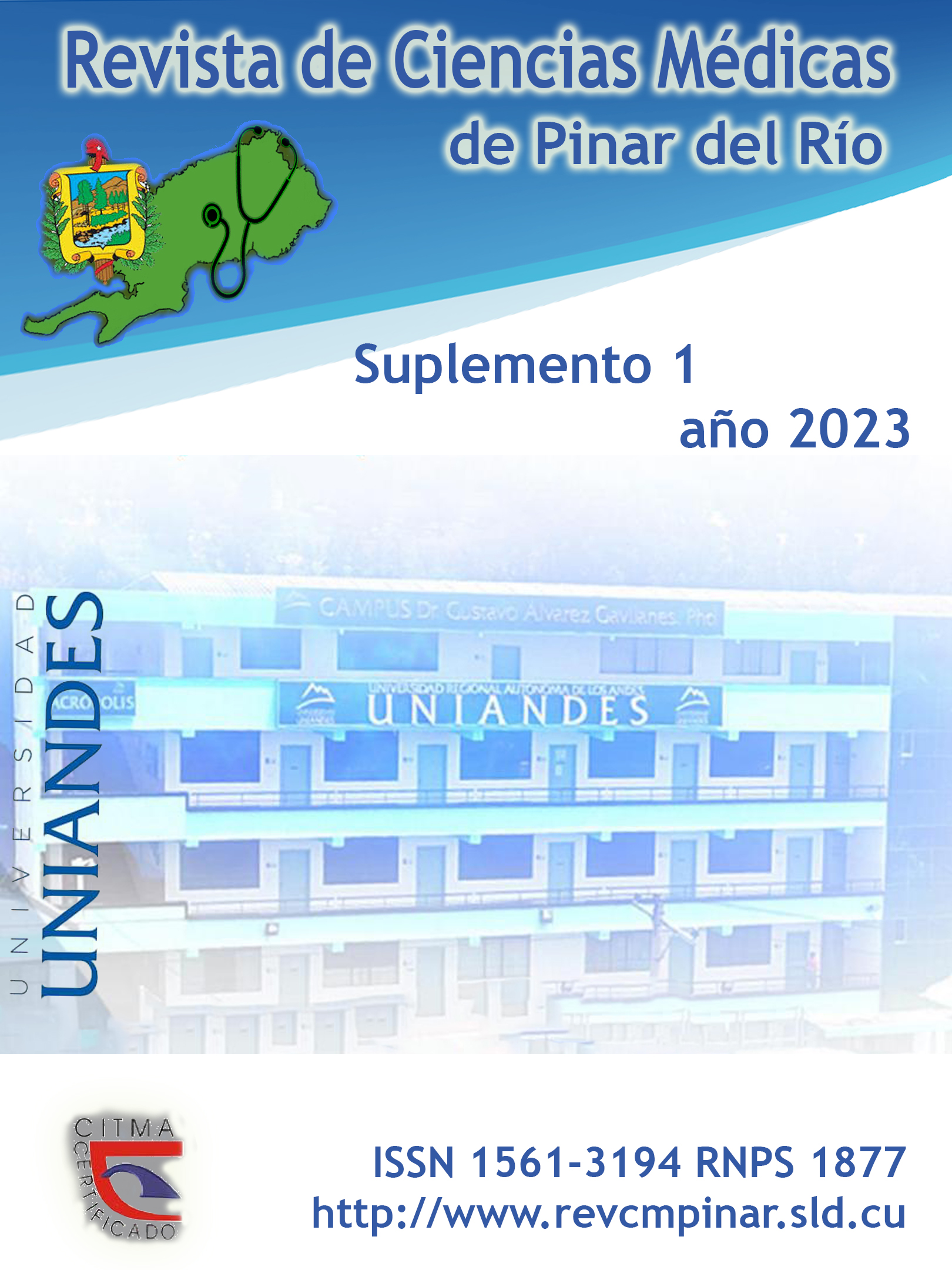Fournier's gangrene in a male patient with insulin-dependent diabetes mellitus: case report
Keywords:
LACRIMAL DUCT OBSTRUCTION, INFANT, NEWBORN, CONGENITAL, SURGICAL PROCEDURES, OPERATIVE.Abstract
Introduction: congenital dacryocele is a rare entity due to nasolacrimal duct obstruction.
Case report: female neonate, 17 days old, born after euthyroid delivery, at term, with no significant prenatal history. She presented with swelling of the right eye since birth, abundant conjunctival secretions and conjunctival hyperemia. Physical examination revealed the presence of an 8 mm diameter tumor in the area of the right lacrimal sac, not painful to palpation, bluish color. Complementary images such as ultrasound were indicated. The diagnosis of congenital dacryocele was determined. Non surgical treatment was decided. Warm compresses were indicated in the area of the affected lacrimal sac for five minutes, three times a day. It was decided to apply antibiotic therapy with tobramycin + dexamethasone in eye drops, one drop every four hours for 10 days. At the end of the treatment, the patient showed improvement, without the need of further interventions. Follow-up by ophthalmology was indicated.
Conclusions: congenital dacryocele is a congenital entity of the lacrimal ducts of low incidence. Its diagnosis is clinical; however, imaging tests are necessary to rule out other entities. Conservative medical treatment may lead to resolution of the entity, with massage and antimicrobial therapy being useful; however, surgical intervention may be required.
Downloads
References
1. He X, Xiang X, Zou Y, Liu B, Liu L, Bi Y, et al. Distinctions between Fournier’s gangrene and lower extremity necrotising fasciitis: microbiology and factors affecting mortality. Int J Infect Dis [Internet]. 2022 [citado 27/09/2022]; 122: 222-9. Disponible en: https://pubmed.ncbi.nlm.nih.gov/35598736/
2. Almaiman SS, Alfraidi OB, Alhathal NK. Fulminant corporal infection induced by Fournier gangrene: A case report with unusual presentation. Urol Case Rep [Internet]. 2022 [citado 27/09/2022]; 40: 101942. Disponible en: https://pubmed.ncbi.nlm.nih.gov/34824979/
3. Basukala S, Khand Y, Pahari S, Shah KB, Shah A. A rare case of retroperitoneal extension in Fournier’s gangrene: A case report and review of literature. Ann Med Surg (Lond) [Internet]. 2022 [citado 17/09/2022]; 77: 103595. Disponible en: https://pubmed.ncbi.nlm.nih.gov/35638004/
4. Calderón W, Camacho JP, Obaíd M, Moraga J, Bravo D, Calderón D. Tratamiento quirúrgico de la gangrena de Fournier. Rev. Cir [Internet]. 2021 [citado 17/09/2022]; 73(2): 150-157. Disponible en: https://www.scielo.cl/scielo.php?pid=S2452-45492021000200150&script=sci_arttext
5. Sobrinho AGB, Geraldelli TV, Bitencourt EL, Brandão RGD, Vaz GP, Galvão JA, et al. Síndrome de fournier em idoso: um relato de caso. Revista de Patologia do Tocantins [Internet]. 2021 [citado 15/09/2022]; 8(3): 71-4. Disponible en: https://sistemas.uft.edu.br/periodicos/index.php/patologia/article/view/12286
6. Cruz Jordán. V, Moncayo Anaslema F, Beltran Alejandro M. Gangrena de Fournier complicada, en hospital de tercer nivel. REVFCM-UG [Internet]. 2022 [citado 21/12/2022]; 3(2): 26-31. Disponible en: https://revistas.ug.edu.ec/index.php/fcm/article/view/1820
7. Egas Ortega W, Granja Rousseau I, Luzuriaga Graf J, Egas Romero W, Moncayo C. Características de los casos de gangrena de Fournier atendidos en el Hospital Luis Vernaza de Guayaquil-Ecuador. Rev Med Vozandes [Internet]. 2017 [citado 17/09/2022]; 28: 27-32. Disponible en: http://fi-admin.bvsalud.org/document/view/843xu
8. Viel-Sánchez P, Despaigne-Salazar R, Mourlot-Ruiz A, Rodríguez-García M, Martínez-Arzola G. Gangrena de Fournier. Revista Cubana de Medicina Militar [Internet]. 2020 [citado 19/09/2022]; 49(1): 206-213. Disponible en: https://revmedmilitar.sld.cu/index.php/mil/article/view/333
9. Díaz-Martínez AR, De los Cobos-Gutiérrez E, Hernández-Ávila PH, Arias-de la Cruz Y, Hernández-González N. Caracterización clínica de pacientes con gangrena de Fournier del Hospital General Docente “Dr. Agostinho Neto”, 2008-2018. Rev Inf Cient [Internet]. 2021 [citado 19/09/2022]; 100(4): e3528. Disponible en: https://revinfcientifica.sld.cu/index.php/ric/article/view/3528
10. Vargas Rubio T, Mora Agüero S de los Ángeles, Zeledón Aguilera AS. Gangrena de Fournier: generalidades. Rev. méd. sinerg [Internet]. 2019 [citado 19/09/2022]; 4(6): 100-17. Disponible en: https://www.revistamedicasinergia.com/index.php/rms/article/view/217
11. Lombardo Vaillant TA. Clinical-epidemiological study on Fournier's gangrene in a Luanda hospital. From January 2016 to December 2021. Medisur [Internet]. 2022 [citado 19/09/2022]; 20(3): 515-526. Disponible en: http://scielo.sld.cu/scielo.php?script=sci_arttext&pid=S1727-897X2022000300515&lng=es
12. Yeniyol CO, Suelozgen T, Arslan M, Ayder AR. Fournier’s gangrene: experience with 25 patients and use of Fournier’s gangrene severity index score. Urology [Internet]. 2004 [citado 19/09/2022]; 64(2): 218-22. Disponible en: https://pubmed.ncbi.nlm.nih.gov/15302463/
13. Lacruz-Pérez B, García-Montero A, Guinot-Bachero J. Abordaje postquirúrgico de un caso de gangrena de Fournier desde atención primaria. Enfermería Dermatológica [Internet]. 2019 [citado 19/09/2022]; 13(37): 52-58. Disponible en: https://dialnet.unirioja.es/servlet/articulo?codigo=7088023
14. Ochoa DXT, Montesinos CEF, Ortiz GIM. Perfil bacteriológico e regimes antibióticos utilizados no tratamento da Gangrena de Fournier. Braz. J. Hea. Rev. [Internet]. 2023 [citado 19/02/2023]; 6(1): 3382-91. Disponible en: https://ojs.brazilianjournals.com.br/ojs/index.php/BJHR/article/view/57287
15. Zakariya-Yousef BI, Trujillo Díaz N, de la Herranz Guerrero P. Grangrena de Fournier secundaria a un absceso inguinoperineal por Acidaminococcus intestini y Streptococcus gallolyticus spp. pasteurianus. Rev Esp Quimioter [Internet]. 2021 [citado 19/02/2023]; 34(6): 679-681. Disponible en: https://www.ncbi.nlm.nih.gov/pmc/articles/PMC8638768/
Downloads
Published
How to Cite
Issue
Section
License
Authors who have publications with this journal agree to the following terms: Authors will retain their copyrights and grant the journal the right of first publication of their work, which will be publication of their work, which will be simultaneously subject to the Creative Commons Attribution License (CC-BY-NC 4.0) that allows third parties to share the work as long as its author and first publication in this journal are indicated.
Authors may adopt other non-exclusive license agreements for distribution of the published version of the work (e.g.: deposit it in an institutional telematic archive or publish it in a volume). Likewise, and according to the recommendations of the Medical Sciences Editorial (ECIMED), authors must declare in each article their contribution according to the CRediT taxonomy (contributor roles). This taxonomy includes 14 roles, which can be used to represent the tasks typically performed by contributors in scientific academic production. It should be consulted in monograph) whenever initial publication in this journal is indicated. Authors are allowed and encouraged to disseminate their work through the Internet (e.g., in institutional telematic archives or on their web page) before and during the submission process, which may produce interesting exchanges and increase citations of the published work. (See The effect of open access). https://casrai.org/credit/



